“There are more things in heaven and earth, Horatio, than are dreamt of in your philosophy.”
So Hamlet, having just conversed with a Ghost, informs his friend, Horatio, incredulous, apparently, because well schooled in Stoic philosophy, Horatio is a rationalist. Engagement with the implications of quantum mechanics is like talking to a Ghost; the experience shakes up notions of reality, and things “un-dreamt” become possible when possibility is itself understood in terms of probability.
The difference between Hamlet’s ghost and quantum mechanics is one of consensus. Maybe one or two physicists believe in the possibility of ghosts, but almost all physicists believe in quantum mechanics. After 100 years of unpacking its implications, physical reality on a deep level has turned out to be much stranger than a 19th-century physicist could have dreamed.
KITP permanent member and solid-state theorist Matthew Fisher believes — counter to the prevailing view in his field — that our everyday world contains aspects which may be far stranger than we can currently envisage or even imagine. “The correlated motion of electrons inside some crystalline materials provides the platform where such exotica might be lurking, largely uncharted,” he said.
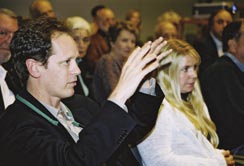 Chalk Talks, a program of the Friends of KITP, enables audience members to ask questions of presenting scientists in a relaxed and casual setting.
Chalk Talks, a program of the Friends of KITP, enables audience members to ask questions of presenting scientists in a relaxed and casual setting.
Photo by Nell Campbell.
In a culture where “thinking outside the box” has become a cliché for creativity, Fisher sees his approach to solid state physics as — quite literally — thinking from the outside about what is going on inside the “box,” which, in his case, is the ordered array of atoms in the crystalline lattice of a solid. His preferred metaphor for this box is a dance hall, in which electrons of spin up and spin down move through the lattice like couples of men and women. Fisher’s task, as he sees it, is trying to discern, from outside the dance hall. the dancing patterns being performed by the swirl of electrons; he is trying, in other words, to guess nature’s quantum choreography.
Though his endeavors may seem abstruse to laymen, Fisher’s box contains not hypothetical dust from an Andromeda moon, but earth rocks — materials which are magnetic and paramagnetic and ferromagnetic, and conducting and semiconducting and superconducting.
This is the physics variously described as “solid state” or “condensed matter,” from which all of our high technology of computer chips and light emitting diodes and lasers has come. This is preeminently the physics for applications and usefulness. Most current high technology is sliced from what Fisher characterizes as the paradigm of solid-state physics. In this standard paradigm, the dance hall is the setting for an orderly, well-understood behavior, in which the dancing electrons are, in the terms of his metaphor, “ultimately rather lonely and disinterested in one another.”
The Paradigm
“Even,” said Fisher, “if a material is cooled to very low temperatures where normally in the classical picture everything stops moving, electrons are so light that quantum mechanics keeps them fluctuating and moving around. Even at the lowest temperature, inside every piece of crystalline material, there is this miraculous electronic world with billions of electrons moving around."
“In the real world, crystals are not perfect, and their inhomogeneities affect the motion of electrons. But by and large, the field of strongly correlated electrons is focusing on the simplest problem of the idealized perfect crystal. If we can’t understand that, we are not going to understand the more complicated, imperfect, real world,” he said.
“What we have in crystalline solids are atoms arranged in an orderly way. Cooling the crystal slows the kinetic energy of its constituent atoms. As an atom’s momentum gets smaller, its wavelength gets comparatively larger, and once the wavelength becomes comparable to the distance between atoms and the size of atoms, the atoms behave like waves. The atom is too massive to manifest that waviness at room temperature. Not so the electrons.”
Treating the nuclei as a set of points, a solid can be viewed as a collection of electrons. “I’m interested,” said Fisher, “in what the electrons are doing because they are so light that even at room temperature they are behaving quantum mechanically. The electron particles are also behaving as waves. The wavelength is the length over which the wave oscillates, and is inversely proportional to the electron’s momentum.” At room temperature, the electron’s wavelength is typically very long — much longer than the distance between atoms. So electrons can look wavy and quantum mechanical at room temperature, and they do.
“If,” said Fisher, “one is interested in understanding the behavior of crystalline solids under ordinary conditions here on earth, it is ultimately necessary to understand the quantum mechanical motion of the electrons around every single atom.”
By and large, the electrons are in orbits around the nuclei of atoms. And they are arranged in shells, which fill up in the order of distance away from the nucleus.
“Take a piece of copper,” said Fisher. “Each copper atom is relatively inert with one extra electron sitting in the outermost shell. That electron can easily move from the sphere of influence of one copper atom to another. So,” said Fisher, “in the background of these billiard balls [the copper atoms with their filled electron shells], you can easily get this fluid of electrons moving around; that is a quantum mechanical fluid called a ‘Fermi liquid.’ The remarkable thing about a Fermi liquid, even though it is a quantum mechanical fluid, is that its behavior can be simply understood mathematically.”
Before quantum mechanics, people didn’t understand the behavior, including the low electrical resistance, of metals because they were thinking of the electrons as billiard balls. But an electron moving in this “periodic potential” (array of atoms) will, according to Fisher, “go into a very nice wave where it can move through the periodic background of atoms as if the atoms are not there.” Felix Bloch (awarded a Nobel Prize in 1952 for first demonstrating and explaining the phenomenon of nuclear magnetic resonance [NMR] in 1946) figured this out in the 1930s soon after the advent of quantum mechanics.
Add another electron and ask what happens. Can it, for instance, collide with the original electron? The Pauli exclusion principle says that electrons, being fermions, cannot do the exact same thing as one another. More precisely, a spin up electron cannot be in the same state as another spin up electron. In addition, any two electrons because they are both negatively charged repel one another — that’s the “Coulomb interaction.”
“Let’s imagine,” suggests Fisher, “that we just turn off the Coulomb interaction; nevertheless, two up spin electrons have an exclusion interaction; they cannot sit on top of one another. You might think,” said Fisher, “it would be a very complicated problem to solve for 1023 electrons moving around as waves that can’t — as particles — sit on top of one another. Miraculously one can solve that problem exactly because these wavelike states each have different momenta, beginning with low and running to high.”
The filled set of momentum states from lowest to highest is called the “Fermi sea.” The filled Fermi sea provides an exact description of the electrons’ dynamics in the absence of Coulomb interactions.
“Even more amazing,” said Fisher, “when you add Coulomb interactions in many important materials such as copper, silicon, iron, and gold, the qualitative behavior of the collective of electrons remains the same. It is as if interactions between electrons do not matter.”
The assumption that it is legitimate to ignore the interactions between the electrons constitutes the backbone of the quantum theory of solids — the standard paradigm of solid-state physics with roots stretching back some 75 years.
It starts with a zero-order description where electrons do not interact at all, and then adds in the (presumed) weak effects of interactions. When two electrons within the Fermi sea interact weakly with one another, there are relatively few empty states available to scatter into, and the number of such accessible states diminishes rapidly upon cooling. In the 1950s, Lev Landau, the famous Russian physicist, developed the requisite mathematical description of this picture. This “Landau Fermi liquid theory” basically takes into account the residual interactions between low energy electrons without changing their qualitative behavior.
But Landau Fermi liquid theory does not always work, asserts Fisher. “In some materials, the interactions between electrons can be so strong that their behavior changes qualitatively. You cannot even think in terms of momentum states; the Fermi sea does not have any sharp meaning.”
First with the quantum Hall effect and then the fractional quantum Hall effect (both efforts netting Nobel Prizes, in 1985 and 1998, respectively), and then even more dramatically in 1986 with the discovery of the high temperature superconductors, physicists began to realize that collections of electrons can be much, much more interesting and complicated than described by Landau Fermi liquid theory.
The quantum Hall effect represented the first well-understood example of electrons behaving in a manner qualitatively different from the standard paradigm. “We understand what the electrons are doing,” said Fisher, “and they are doing something amazingly interesting simply because they are doing something other than ignoring one another. Though the quantum Hall effect occurs only in special circumstances, our understanding of it has convinced us that qualitatively different behavior is possible.”
Divining the Dance
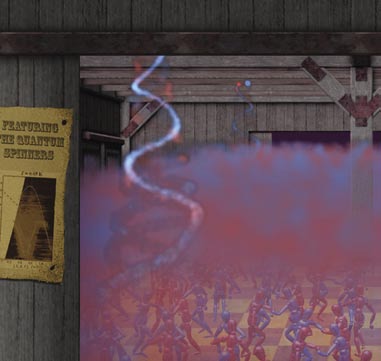 Artist's representation of the conceptual process for divining quantum choreography
Artist's representation of the conceptual process for divining quantum choreography
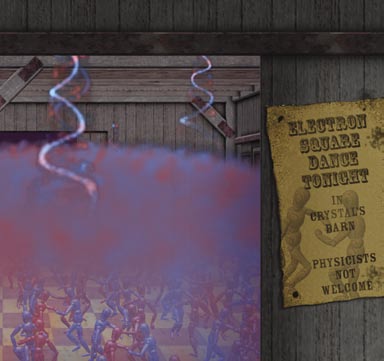 Illustrated by Peter Allen.
Illustrated by Peter Allen.
“Imagine a town hall with a dance going on, but to which no physicists are admitted though couples enter and music is audible,” said Fisher. “The problem for the physicists is to guess the dance pattern inside."
“One way — one experiment — would be to start pushing people in the front door and see how quickly people come out the back door. That way you could tell how crowded the hall is. Or you could push in women, and see how quickly men come out or women; that way you could get some idea how tightly bound the men and women are (this method of probing is called ‘electrical transport’)."
“Another thing you might want to do is listen to the vibrations of the music — akin to observing scattered neutrons to infer the ‘vibrations’ of the electrons’ spin."
“Or, perhaps you climb on the roof of the dance hall and drop people in through a skylight and listen to the commotion below when they land on the floor amidst the dancers. This might give one some idea of how crowded the room is with dancers. This tactic is analogous to tunneling electrons from a metallic tip into a solid, in order to determine the behavior of the electrons inside the solid,” said Fisher.
Within the standard Fermi liquid paradigm, how would one describe the dancing within the hall? “People walk straight through the room, bump into a wall, and bounce off,” said Fisher, describing people moving like zombies in a low-budget horror film. “Most condensed matter theorists today,” said Fisher, “do not believe that thinking in terms of more exotic quantum choreography will be productive; 95 percent of the practitioners prefer contemplating adding bells and whistles to the true and tested Fermi liquid approach."
“Phil Anderson [Princeton physicist and 1977 Nobel laureate] was perhaps the first physicist who clearly envisioned that there was much more out there than such bells and whistles. Motivated by a particular class of materials, he made a guess in the 1970s that intuited what is, in the hindsight of my present thinking, quantum choreography. It was a stroke of genius. He saw a kind of dance pattern, although at the time he did not understand it fully in mathematical terms. As soon as high temperature superconductivity was discovered over a decade later, he resurrected this quantum dance and suggested that it should underlie the strange electronic behavior of these materials. His insight was initially well received, but has since largely fallen out of favor. A few diehards, though, have continued to refine, develop and generalize the original quantum choreography. In the past five years, there has been a good deal of progress in exploring toy models, which can be shown to manifest Anderson’s very first quantum dance proposed over 30 years earlier.”
What about high temperature superconductivity? The researchers who discovered it in 1986 got a Nobel Prize in 1987. In the meantime, 20 years have passed, and over 100,000 experiments have been conducted. Is it understood yet?
Replied Fisher, “We have not yet been sufficiently creative; I don’t believe that we have yet guessed the right choreography.”
Quantum choreography is not easy. Even Fisher’s examples of how one might go about guessing quantum choreography in terms, not of mathematics, but square dancing are not easy.
“Just like the docey-doe in square dancing, where a couple pairs together and dances about one another, electrons sometimes like pairing. A quantum docey-doe of two electrons is often akin to a ‘valence bond.’ But sometimes, just like men and women who tire of dancing with the same partner,” said Fisher, “electrons become ‘swingers’ switching between different partners. The ‘resonating valence bond state’ proposed by Anderson in the 1970s is a quantum analog of square dancing’s ‘grand right and left’ in which everybody dances with everyone of the opposite sex on the dance floor."
“If the dance floor is disturbed appropriately,” said Fisher, “a pair of dancers can become separated. The lone man (an up spin electron) will quickly impose upon another — stealing his partner — only to leave another lonesome ‘gent.’ Similarly, for the woman (the spin down electron). The net effect is that, at any time, there will be an unpaired male and female traversing about the dance floor. Each loner will carry the electron’s spin (spin one-half) and has been christened a ‘spinon.’"
“The electrons’ charge, which is simply determined by the total number of people irrespective of sex, will be uniform throughout the dance floor, so that the spinons are effectively electrically neutral with respect to the background density of dancers. In particle physics, the spin and charge of an electron are enslaved, always moving together. But in this strange hall filled with twirling dancers, the electron’s spin is effectively separated from its charge — a phenomena called ‘spin-charge’ separation.”
Fisher often prefers visualizing such intricate quantum choreography in terms of “vortices,” places on the dance floor around which dancers are twirling. “Particles are waves and waves have phases, they can swirl around in a current called a ‘vortex.’ I can describe various dance patterns by focusing on the quantum motion of the places where they are rotating rather than looking at individual electrons.”
There is much quantum choreography to divine. Spinning vortices and triangular (instead of square) lattice dance halls, where (perhaps strangest of all) critical spin liquids can take the floor.
In such critical spin liquids, a female dancer can be paired, or entangled, with a male clear across the dance floor. Dancing pairs come in all sizes, intertwined with one another. And partners are continuously being swapped. Moreover, the “spinon” — the unpaired male or female dancer — moves across the dance floor in a very complex manner, due to partner swapping between well-separated pairs. “It is impossible to describe the motion of this spinon as a quantum mechanical particle,” said Fisher. “It doesn’t behave like a boson; it doesn’t behave like a fermion. It doesn’t behave like a free particle at all. It is,” said Fisher, “an element of a strongly interacting theory.”
Such exotic quantum choreography is possible largely due to the “frustration” inherent in the triangular lattice, according to Fisher. “I am very excited by the quantum antiferromagnet on the triangular lattice and other frustrated lattices,” said Fisher. “It’s a situation where men and women like to be next to one another, but can’t all be, so they all can’t be happy. This leads to interesting collective behavior, driven by compromises, much as in complex human societies.” On triangular lattices, there are presently two experimental materials, which are good candidates for being critical spin liquids.
Fisher has focused for over two decades on building up an intuition for quantum choreography. “I think that eventually we will successfully ascertain the correct quantum choreography that underlies the mysterious behavior in materials such as the high temperature superconductors and heavy fermion materials. Each class might conceivably have its own distinctive choreography.” He says he doesn’t have a feel for whether the classes will themselves be classifiable into an overarching pattern.
Besides high temperature superconductors, strongly correlated electron systems hold another tantalizing prospect for applications — in terms of quantum computing. “Correlation” is basically the name of the game in quantum computing.
“Some people think the solid state physics done here in Santa Barbara is simply crazy; others are more receptive,” said Fisher. “There is a strong orthodoxy in the solid-state physics community [and more physicists are members of this community than any other], an orthodoxy which is amazingly powerful when it works. Expressing a strong preference for exploring what does not fit should not be taken as dismissal of the original paradigm. Quantum mechanics didn’t mean Newton was a fool.”
But searching for a new paradigm has been challenging, and at times dispiriting. “About five years back, together with T. Senthil, after extending some of Phil’s early ideas, we proposed an experiment which could be used to unambiguously determine whether or not the simplest resonating valence bond state was responsible for the behavior observed in the underdoped cuprates. The theoretical foundations were sufficiently clear to put forward a concrete and falsifiable prediction for an eminently doable experiment. We were shortly proved wrong."
“It takes a certain personality,” he said, “to push optimistically, if not blindly, into creative new directions. There is a real fear of being misguided. But until ideas are sufficiently well formulated to enable testable predictions, one should persist. Without taking the risk of being wrong, you can’t have new ideas.”
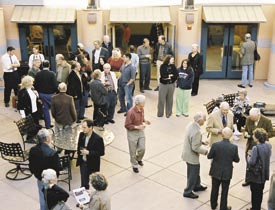
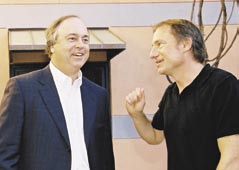
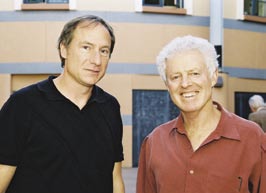
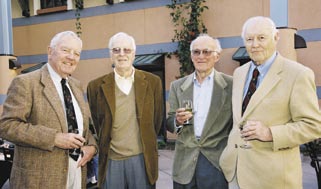
Clockwise from top left:
1: Friends of KITP gather in the Kohn Hall courtyard before attending a Chalk Talk in the main auditorium by KITP permanent member Matthew Fisher
2: Matthew Fisher (above, r), Chalk Talk speaker and KITP permanent member, met Friends, such as John Mackall (above, l), chair of the KITP Director’s Council.
3: Matthew Fisher (l), KITP permanent member, discusses his Chalk Talk, “Quantum Crystals, Quantum Choreography and Quantum Computing,” with Derek Westen, chair of Friends of KITP.
4: Friends of KITP, Glen Mitchel (l), Dr. Eugene Ellis, Gunnar Bergman, and Samuel Fordyce.
— Photos by Nell Campbell
